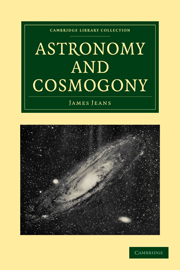Book contents
- Frontmatter
- Contents
- LIST OF ILLUSTRATIONS
- PREFACE
- CHAP. I The Astronomical Survey of the Universe
- CHAP. II The Light from the Stars
- CHAP. III Gaseous Stars
- CHAP. IV The Source of Stellar Energy
- CHAP. V Liquid Stars
- CHAP. VI The Evolution of the Stars
- CHAP. VII Non-spherical Masses–Dynamical Principles
- CHAP. VIII The Configurations of Rotating Liquid Masses
- CHAP. IX The Configurations of Rotating Compressible Masses
- CHAP. X Rotation and Fission of Stars
- CHAP. XI The Evolution of Binary Systems
- CHAP. XII The Ages of the Stars
- CHAP. XIII The Great Nebulae
- CHAP. XIV The Galactic System of Stars
- CHAP. XV Variable Stars
- CHAP. XVI The Solar System
- CHAP. XVII Conclusion
- Index of Subjects
- Index of Names
CHAP. VI - The Evolution of the Stars
Published online by Cambridge University Press: 07 September 2010
- Frontmatter
- Contents
- LIST OF ILLUSTRATIONS
- PREFACE
- CHAP. I The Astronomical Survey of the Universe
- CHAP. II The Light from the Stars
- CHAP. III Gaseous Stars
- CHAP. IV The Source of Stellar Energy
- CHAP. V Liquid Stars
- CHAP. VI The Evolution of the Stars
- CHAP. VII Non-spherical Masses–Dynamical Principles
- CHAP. VIII The Configurations of Rotating Liquid Masses
- CHAP. IX The Configurations of Rotating Compressible Masses
- CHAP. X Rotation and Fission of Stars
- CHAP. XI The Evolution of Binary Systems
- CHAP. XII The Ages of the Stars
- CHAP. XIII The Great Nebulae
- CHAP. XIV The Galactic System of Stars
- CHAP. XV Variable Stars
- CHAP. XVI The Solar System
- CHAP. XVII Conclusion
- Index of Subjects
- Index of Names
Summary
GENERAL PRINCIPLES
The early spectroscopists believed that the spectrum of a star provided a sure indication of the star's age. Huggins and Lockyer had found, for instance, that the spectrum of Sirius exhibited hydrogen lines very strongly and calcium lines rather weakly; in the solar spectrum the relative strength of these two sets of lines was reversed, calcium being strong and hydrogen weak. They concluded that hydrogen was specially prominent in the constitution of Sirius and calcium in that of the sun. Believing that Sirius must one day develop into a star similar to our sun, they conjectured that its substance must gradually change from hydrogen into calcium and other more complex elements, thus finding support for the long-established hypothesis that the more complex elements were formed by gradual evolution out of the simplest. In this way they were led to regard a star's spectrum as an index to its age.
As we have seen, the true interpretation of these observations is merely that the surface of Sirius is at a temperature at which hydrogen is specially active in emitting and absorbing radiation, while the sun's surface is at a lower temperature at which hydrogen is comparatively inert, while calcium, iron, etc., have become active in its place.
- Type
- Chapter
- Information
- Astronomy and Cosmogony , pp. 166 - 186Publisher: Cambridge University PressPrint publication year: 2009First published in: 1928



